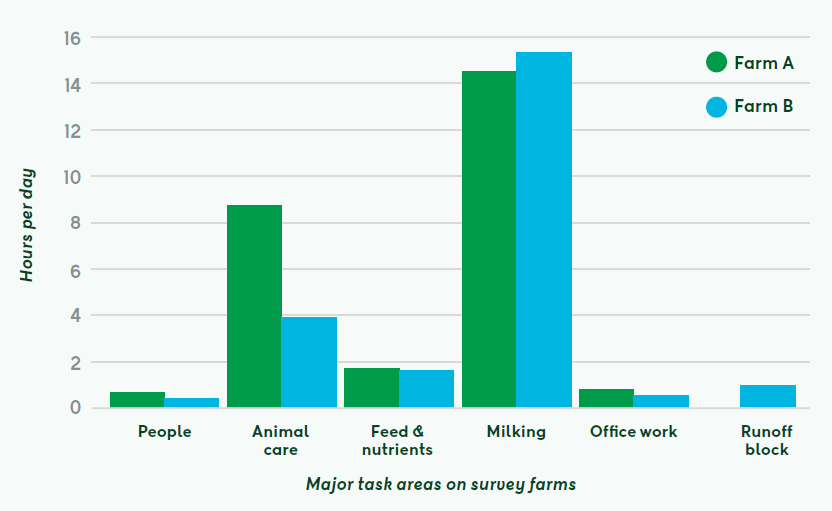Workplace Productivity Study
2 min read
This research project took an in-depth look at over 154 dairy farms to understand workplace efficiency, and how that varies between farm sizes. It focused on understanding how factors like different farm systems, farm size and technologies impacted annual hours worked. Find out how productive the surveyed dairy farms were and what the opportunities are.
Historically, dairy workplace efficiency has been measured by looking at the number of cows, full-time workers, and kilograms of milksolids produced, or by milking-based metrics such as cows milked per person, per hour.
The Workplace Productivity Study was designed to look at productivity and workplace practices on a deeper level, examining how factors like different farm systems, farm size and technologies influence annual hours worked, seasonal hours and time spent on specific tasks.
DairyNZ and QCONZ surveyed 154 farms across New Zealand between November 2022 and March 2023.
Survey questions focused on:
When looking into total hours worked across the season, there were a large range in hours worked between similar-sized farms. For example, one 500-cow farm was being run with around 5000 hours/year, while another 500-cow farm was being run with around 12,000 hours/year. This shows a potential opportunity for productivity gains.
The data also showed hours worked per cow per year is not influenced by kilograms of milksolids per cow (kg MS/cow), and that some farms are achieving a greater kg MS/cow/year without increasing the number of hours worked.
A task breakdown was used to identify where hours were being spent across the year per person. Again, our study showed big differences between similar-sized farms. For example, two 500-cow farms varied in time spent on animal care tasks, like calving, and work on a runoff block (see graph).
Data indicated that a greater level of shed automation (such as automated cup removers, automatic teat spray and automated drafting) was linked with fewer hours worked per person per week.

Breakdown of tasks
People: team meetings and people management, daily farm planning
Animal care: calving, calf rearing, animal health, breeding and other stock work
Feed and nutrients: pasture assessment and planning, break fencing, feeding supplements, irrigation, fertiliser application, effluent management, daily farm planning
Milking: herding cows, vat wash, milking (cups on to cups off), plant and yard wash
Office work: data entry/compliance, financial and other admin tasks
Run-off: time spent managing activities on a run-off/wintering block
Non-work time: time off/breaks during the day (not annual leave)
Monthly tasks: cropping and pasture renovation, pasture conservation, general repairs and maintainance, staff training, other meetings/professional activities.
Data modelling was used to estimate the hours per week required to run farms with different herd sizes, so farmers have a benchmark to compare with their own farms.
| Estimated hours in the week |
100 cows | 200 cows | 400 cows | 600 cows | 800 cows | 1000 cows |
| Calving | 96 | 121 | 169 | 218 | 267 | 316 |
| Mating | 85 | 104 | 143 | 182 | 220 | 259 |
| Mid lactation | 72 | 89 | 122 | 156 | 189 | 223 |
| Dry period | 47 | 62 | 93 | 124 | 155 | 186 |
We’ll be analysing the dataset further to identify key drivers for improving workplace productivity.
The next actions are:
Check back here for updates on future research around workplace productivity.
The results from this research have helped create a productivity dataset where farmers can compare their farms against similar farms to see where there are opportunities to save time and the potential impact of different trying different practices and technologies.
A social scientist, Callum leads projects in workplace design, workplace productivity, reducing dairy sprains and strains, and technology adoption. He specialises in technology adoption and integration using innovative and practical solutions on farm. Callum works closely with farmers and enjoys using co-design approaches to bring different perspectives to solving farming challenges, this includes having farmers and other stakeholders in the room together. For Callum, it's not just about creating science solutions, but ensuring they work for farmers.
A research engineer, Brian enjoys working alongside farmers and technology developers to better understand farmer needs and opportunities to improve workforce productivity and workplace design. Providing information to support farmers in making investment decisions in technologies that will add value to their farm business and work well for their farm teams is a key part of his role.
A post-doctoral scientist, Lucy is passionate about and has developed research skills related to people on farms and farm systems. Her key research areas are workplace productivity, flexible milking, the impact of on-farm safety improvement practices, and farmer’s sleep. Lucy has a wealth of practical on-farm knowledge. She has previously worked on dairy farms and supported farmers through running discussion groups at DairyNZ. After finishing her Ph.D., Lucy is eager to provide research that considers the whole farm system and helps farmers remain dairy leaders internationally.
Research teamNow’s the perfect time to check in, plan, and set up for a strong season. We’ve pulled together smart tips and tools to help you stay ahead all winter long.
Whether you prefer to read, listen, or download handy guides, we’ve got you covered with trusted tools to support your journey every step of the way.